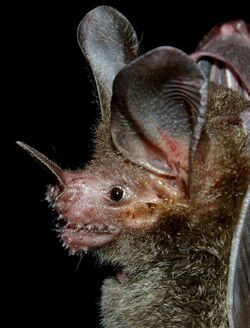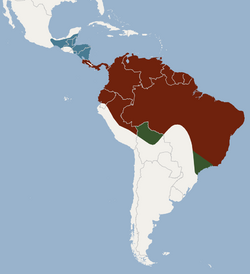Biology:Fringe-lipped bat
| Fringe-lipped bat | |
|---|---|

| |
| Scientific classification | |
| Domain: | Eukaryota |
| Kingdom: | Animalia |
| Phylum: | Chordata |
| Class: | Mammalia |
| Order: | Chiroptera |
| Family: | Phyllostomidae |
| Genus: | Trachops Gray, 1847 |
| Species: | T. cirrhosus
|
| Binomial name | |
| Trachops cirrhosus (Spix, 1823)
| |

| |
| Distribution of the fringe-lipped bat | |
The fringe-lipped bat (Trachops cirrhosus) is a leaf-nosed bat from southern Mexico to Bolivia and southern Brazil. It has three subspecies and no known fossils. It is the only species within its genus.
Morphology
The fringe-lipped bat has wart-like bumps on its lips and muzzle, which give it its name. The bat has an overall color of a reddish brown with gray on its belly. The fur is long and woolly. It is medium in size, about 32 grams.[2]
The tail is short. It has a nose-leaf with serrated edges. It has two pairs of lower incisors with three pairs of lower premolars. The molars have tubercular depressions with w-shaped cusps. The rostrum is shorter than the braincase but equal to the width of the braincase. It has a low wing-aspect ratio and high wing loading.[3]
Reproduction and development
The fringe-lipped bat generally mates during the dry season in the tropics, usually from January to June. There is no real difference in appearance between the male and the female. It gives birth to one offspring at a time. The young can stay with the parents for a considerable amount of time.[3])
Ecology
Its preferred habitat is near ponds or streams. It roosts in trees or hollow logs and sometimes in caves. It likes tropical dry and moist forests. Trachops cirrhosus is an opportunistic foliage-gleaning omnivore, eating mainly insects with some lizards, frogs (such as Hyalinobatrachium fleischmanni),[4][5] fruits, and seeds. In rare cases this species has been idententified eating bats such as Furipterus horrens.[6] It sometimes shares roosts with other species of bats. It is sometimes preyed upon by gray four-eyed opossums.[3]
Behavior
Trachops cirrhosus roost in groups of up to 50 individuals and both sexes roost together. They emerge from the roosts early when there is still daylight because that is the best time to hunt frogs. They hunt in continuous flight or sally out from perches. They hunt by following sounds of insects and frogs[4] and also by using echolocation.[3] Some frog species, such as Smilisca sila, have evolved methods of acoustic crypsis to confuse auditory predators like T. cirrhosus. This is done by synchronizing the timing of calls.[7]
Conservation
The current conservation status of Trachops cirrhosus is least concern because its populations are currently stable.[8] Because it is stable there are no conservation action plans. But because of its feeding habits, it is placed in a precarious position that puts it at a risk from human activity.[2]
Gallery
References
- ↑ Miller, B.; Reid, F.; Arroyo-Cabrales, J.; Cuarón, A.D.; de Grammont, P.C. (2015). "Trachops cirrhosus". IUCN Red List of Threatened Species 2015: e.T22029A22042903. doi:10.2305/IUCN.UK.2015-4.RLTS.T22029A22042903.en. https://www.iucnredlist.org/species/22029/22042903. Retrieved 12 November 2021.
- ↑ Jump up to: 2.0 2.1 Garog, A. 1999.Trachops cirrhosus (On-line), Animal Diversity Web. accessed December04, 2008 at [1].
- ↑ Jump up to: 3.0 3.1 3.2 3.3 Cramer, M.J., Willig, M.R., & Jones, C. 2001.Trachops cirrhosus. Mammalian Species.656:1-6.
- ↑ Jump up to: 4.0 4.1 Ryan, MJ; Tuttle, MD; AS, Rand (Jan 1982). "Bat predation and sexual advertisement in a neotropical anuran". The American Naturalist 119 (1): 136–139. doi:10.1086/283899. http://web.biosci.utexas.edu/ryan/Publications/1980-82/1982AmNat119-136.pdf. Retrieved 11 November 2019.
- ↑ Tuttle, Merlin D.; Ryan, Michael J. (1981-11-06). "Bat Predation and the Evolution of Frog Vocalizations in the Neotropics" (in en). Science 214 (4521): 677–678. doi:10.1126/science.214.4521.677. ISSN 0036-8075. https://www.science.org/doi/10.1126/science.214.4521.677.
- ↑ "Bat predation by the Fringe-lipped bat". Mammalia 64 (2): 241–258. 2009. doi:10.1515/mamm.2000.64.2.241. ISSN 1864-1547. https://www.degruyter.com/view/j/mamm.2000.64.issue-2/mamm.2000.64.2.241/mamm.2000.64.2.241.xml.
- ↑ Legett, Henry D.; Page, Rachel A.; Bernal, Ximena E. (2019-10-09). "Synchronized mating signals in a communication network: the challenge of avoiding predators while attracting mates" (in en). Proceedings of the Royal Society B: Biological Sciences 286 (1912): 20191067. doi:10.1098/rspb.2019.1067. ISSN 0962-8452. PMC 6790779. https://royalsocietypublishing.org/doi/10.1098/rspb.2019.1067.
- ↑ *Miller, B.; Reid, F.; Arroyo-Cabrales, J.; Cuarón, A.D.; de Grammont, P.C. (2015). "Trachops cirrhosus". IUCN Red List of Threatened Species 2015: e.T22029A22042903. doi:10.2305/IUCN.UK.2015-4.RLTS.T22029A22042903.en. https://www.iucnredlist.org/species/22029/22042903. Retrieved 12 November 2021.
Further reading
- Tuttle, Merlin D. (January 1982). "The Amazing Frog-Eating Bat". National Geographic 161 (1): 78–91. ISSN 0027-9358. OCLC 643483454.
External links
Wikidata ☰ Q1445531 entry
 |




